Singh N. (ed.) Radioisotopes - Applications in Physical Sciences
Подождите немного. Документ загружается.

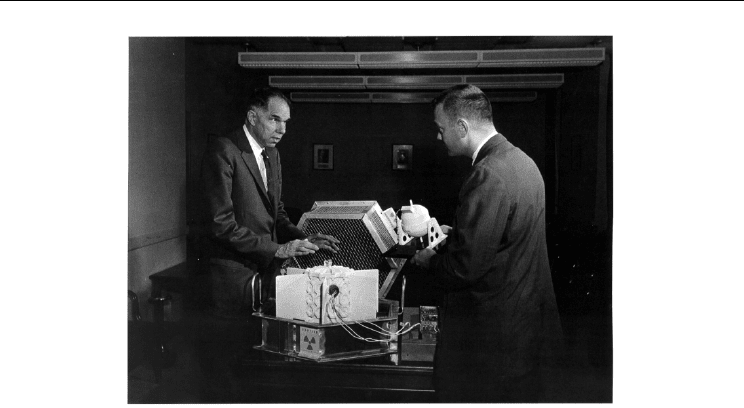
U.S. Space Radioisotope Power Systems and Applications: Past, Present and Future
479
Fig. 5. Nobel Laureate Glenn T. Seaborg, Chairman of the U.S. Atomic Energy
Commission, with his hands over a model of the SNAP-9A RTG and program manager
Major Robert T. Carpenter holding a model of the SNAP-3B RTG (circa 1963), (AEC). The
SNAP-3B RTG produced 2.7 We in a package 12.1-cm in diameter and 14-cm high with a
mass of 2.1 kg. The SNAP-9A RTG produced over 25 We at beginning of mission (BOM)
within a mass of 12.3 kg and a main body that was 22.9 cm in diameter and 21.3 cm high.
(Image credit: AEC)
3.2 SNAP-9A RTGs
The success of the SNAP-3B RTGs on Transits 4A and 4B gave the Johns Hopkins University
Applied Physics Laboratory (JHU/APL) confidence to select the next-generation RTG,
known as SNAP-9A, to provide all the power for its Transit 5BN-1 and 5BN-2 navigational
satellites. The objective for each SNAP-9A was to provide 25 We at beginning of mission
(BOM) at a nominal 6 V for five years in space after one year of storage on Earth. The two
SNAP-9As showed that RTGs could be easily integrated into a spacecraft to provide all of
the electrical power (Bennett, et al., 1984, JHU/APL, 1980). Figure 5 provides a size
comparison between the SNAP-9A and its predecessor the SNAP-3B.
4. SNAP-19 RTGs
The development work on the SNAP-9A RTG provided the technology that led to the
SNAP-19 RTGs which were the first use of nuclear power in space by NASA.
4.1 Nimbus III
In 1969, NASA successfully launched the Nimbus III meteorological satellite powered by
two SNAP-19 RTGs and solar arrays. The two SNAP-19 RTGs, which produced 56.4 We at
launch, provided about 20% of the total power of the spacecraft. Had the SNAP-19 RTGs
not been onboard Nimbus III, the power would have fallen below the load line about two
weeks into the mission because of solar array degradation (Bennett, et al., 1984).
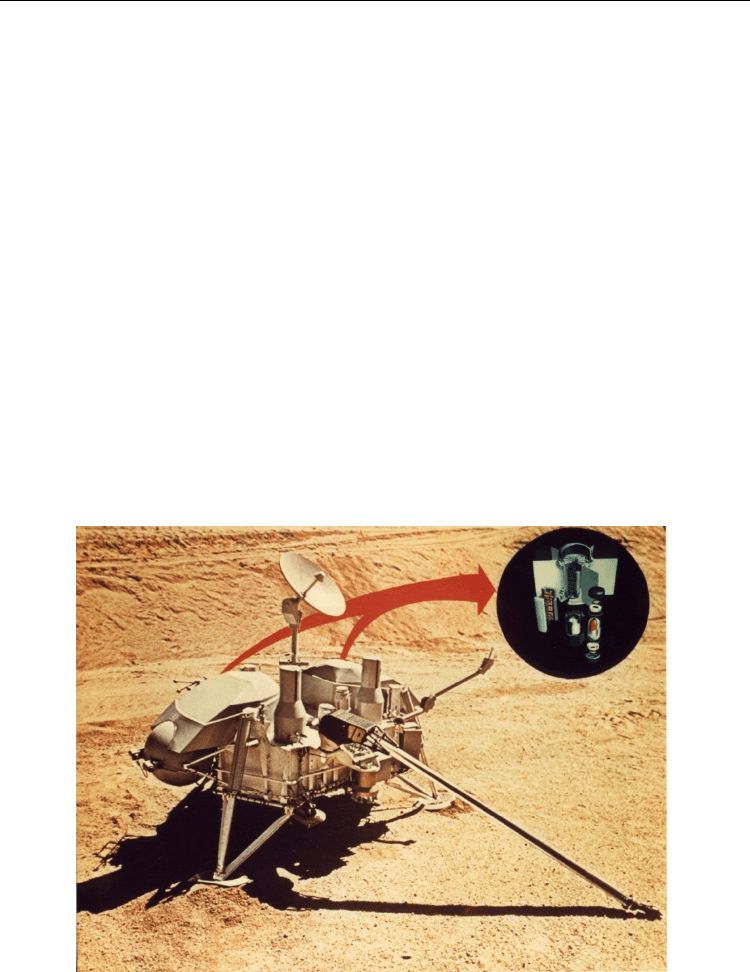
Radioisotopes – Applications in Physical Sciences
480
4.2 Pioneers 10 and 11
In 1972, NASA began its exploration of the outer Solar System with the launch to Jupiter of
Pioneer 10 powered by four SNAP-19 RTGs which produced a total of 161.2 We at BOM.
The next year Pioneer 10 was followed by the Pioneer 11 spacecraft which was also powered
by four SNAP-19 RTGs. In the cold, dark, radiation-rich environment of the Jovian system,
nuclear power was the only viable option at that time. Because the SNAP-19 RTGs
performed so well, NASA was able to retarget Pioneer 11 to go to Saturn after its flyby of
Jupiter. Again, the RTGs performed very well, providing steady power to the spacecraft
and its scientific instruments, thus allowing scientists their first close-up measurements of
the second largest planet in the Solar System (Bennett, et al., 1984).
4.3 Viking Landers 1 and 2
In anticipation of the 200
th
anniversary in 1976 of the signing of the U.S. Declaration of
Independence, NASA launched the two Viking missions in 1975, each launch carrying an
Orbiter and a Lander. Each Lander was powered by two SNAP-19 RTGs specially modified
to work on the surface of Mars (see Fig. 6). The 35-We Viking SNAP-19 RTGs contained a
special dome allowing an interchange of internal gases (initial fill 90:10 helium-argon;
reservoir fill 95:5 argon-helium) during operation on the surface of Mars. This allowed for
reduced pre-launch temperatures and maximum power output on Mars. All four SNAP-19
RTGs easily met the 90-day operating requirement of the Landers and went on to power the
Landers for up to six years giving scientists their first extraordinary in-situ views of the
surface of Mars (Bennett, et al., 1984).
Fig. 6. Viking Lander model showing the location of the two SNAP-19 RTGs. The average
power per RTG was 42.7 We at BOM. The overall RTG diameter (across fins) was 58.7 cm
and the overall length was 40.4 cm. The mass was 15.2 kg. (Image credit:
NASA/JPL/Caltech/ERDA/Teledyne)

U.S. Space Radioisotope Power Systems and Applications: Past, Present and Future
481
The success of the Viking SNAP-19 RTGs was a key factor in the selection of the telluride-
thermoelectric-based Multi-Mission Radioisotope Thermoelectric Generator (MMRTG) for
the upcoming MSL mission (see Section 8).
5. Transit RTG
The successful use of the SNAP-9A RTGs on the Transit 5BN series of Navy navigational
satellites led JHU/APL to use a new telluride-based RTG called the “Transit RTG” on its
TRIAD navigational satellite. The Transit RTG was based on the SNAP-19 radioisotope
heat source design although in this case radiatively coupled to a telluride-based
thermoelectric converter instead of being conductively coupled as in the SNAP-19 and
SNAP-9A RTGs.
The Transit RTG, which was designed to be modular, produced over 35 We at BOM within a
mass of about 13.6 kg. The use of a lower hot-junction temperature (~674 K for the Transit
RTG versus ~790+ K for the SNAP-19 RTGs) in a vacuum environment eliminated the
SNAP-19 practice of using hermetic sealing and a cover gas to inhibit the sublimation
degradation that could cause a reduction in cross section and subsequent increase in
electrical resistance of the thermoelectric material. (Lowering the hot junction temperature
is also one of the strategies adopted for the MMRTG.) While the TRIAD spacecraft had
various problems, the Transit RTG operated well beyond its five-year requirement (Bennett,
et al., 1984).
6. SNAP-27 on Apollo
For the Apollo missions to the Moon, RTGs were a natural choice to power scientific
instruments during the long (14-Earth-day) lunar night. To provide this power, the U.S.
Atomic Energy Commission (AEC) provided NASA with SNAP-27 RTGs built by General
Electric (GE, now part of Lockheed-Martin). The SNAP-27 RTGs were designed to provide
at least 63.5 We at 16 V one year after lunar emplacement. (In the case of Apollo 17, the
requirement was 69 We two years after emplacement). Figure 7 shows Apollo 12
astronaut Alan L. Bean removing the SNAP-27 fuel-cask assembly from the Lunar Module
on 19 November 1969. This was the first use of electricity-producing nuclear power on
the Moon.
All five SNAP-27 RTGs (Apollo 12, 14, 15, 16, 17) exceeded their mission requirements in
both power and lifetime thereby enabling the Apollo Lunar Surface Experiment Packages
(ALSEPs) to gather long-term scientific data on the internal structure and composition of the
Moon, the composition of the lunar atmosphere, the state of the lunar interior, and the
genesis of lunar surface features (Pitrolo, et al., 1969, Bates, et al., 1979). On Apollo 11 the
experiment package deployed on the lunar surface was named Early Apollo Scientific
Experiments Package (EASAP) and consisted of the laser ranging retro-reflector (LRRR, also
deployed on each following Apollo mission, and are still in use today) and the passive
seismic experiments package (PSEP). The PSEP utilized 2 RHUs called the Apollo Lunar
Radioisotopic Heater (ALRH) for thermal control (Apollo 11 Lunar Landing Mission Press
Kit, 1969) and also had a solar array power system that lasted three weeks. The ALRHs
contained ~34 gm of
238
Pu producing 15 W
th
each. The subsequent PSEP stations utilized
power from the SNAP-27 RTGs.
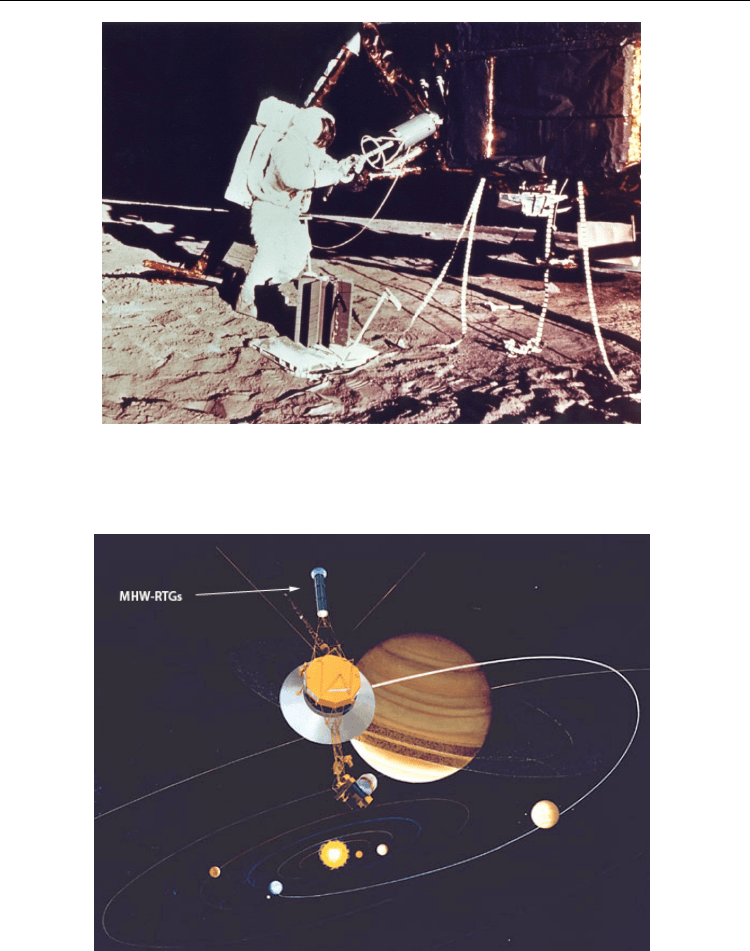
Radioisotopes – Applications in Physical Sciences
482
Fig. 7. Apollo 12 astronaut Alan L. Bean removing the SNAP-27 fuel-cask assembly from the
Lunar Module. The SNAP-27 converter is shown in front of Bean ready to receive the fuel-
cask assembly. (NASA)
Fig. 8. Artist’s concept of a Voyager spacecraft flying by Jupiter and Saturn. The three
MHW-RTGs are shown on the boom above the spacecraft. The average power of each
MHW-RTG was 158 We. The overall diameter was 39.73 cm and the length was 58.31 cm.
The average flight mass for a Voyager MHW-RTG was 37.69 kg.
(Image credit: NASA/JPL/Caltech)
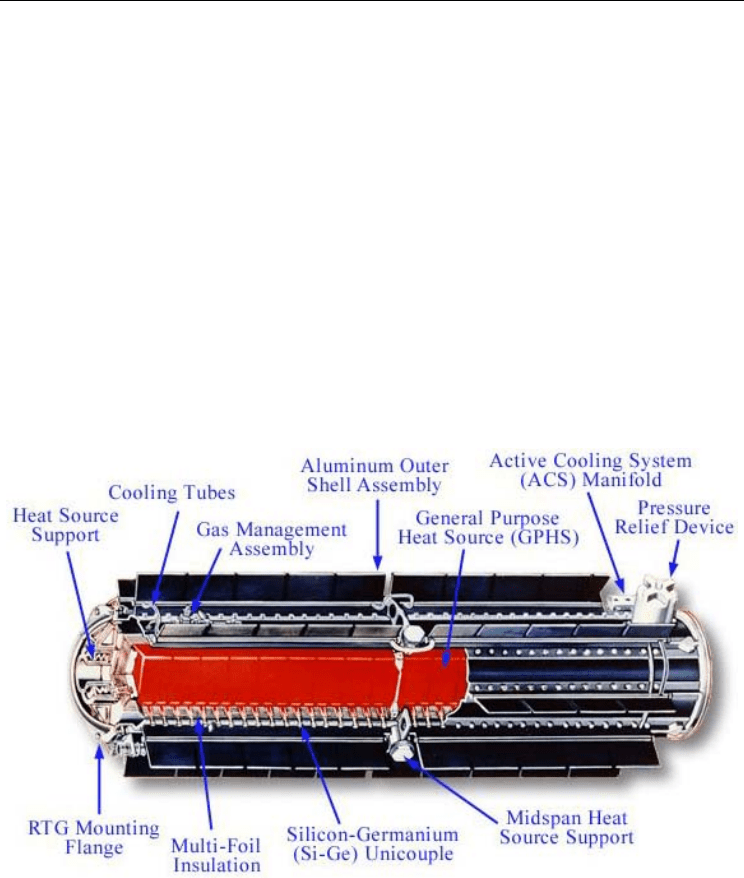
U.S. Space Radioisotope Power Systems and Applications: Past, Present and Future
483
7. Silicon-germanium RTGs
With NASA developing the higher-powered Voyager 1 and Voyager 2 spacecraft (see
Figure 8) as the next generation of outer planet explorers the bar was raised for RTG
performance. To meet this demand, the AEC funded GE (now part of Lockheed-Martin)
to develop the Multi-Hundred Watt Radioisotope Thermoelectric Generator (MHW-
RTG), which was based on the use of a silicon-germanium alloy. Silicon-germanium, as
noted earlier, can be operated at higher temperatures (~1300 K) than the telluride-based
thermoelectrics (~800-900 K). Higher temperatures mean higher heat rejection
temperatures, which mean smaller radiators hence lower unit masses. Combining the
higher temperature with multifoil insulation (instead of bulk insulation) and vacuum
operation (instead of using a cover gas) can yield a specific power that is 40% to over
70% higher than that of a telluride-based RTG (Bennett, et al., 1984). The basic layout of a
silicon-germanium RTG is shown in Figure 9.
Fig. 9. Cutaway of the General-Purpose Heat Source Radioisotope Thermoelectric Generator
(GPHS-RTG).
The GPHS-RTG can produce over 300 We at initial fueling. The overall diameter is 42.2 cm
and the length is 114 cm. The mass is 55.9 kg (Image credit: DOE).

Radioisotopes – Applications in Physical Sciences
484
7.1 MHW-RTG
The MHW-RTG objective was to provide at least 125 We after five years in space. It was
designed to produce at least 150 We at BOM, making it the highest-powered RTG at the
time (1970s). Once the program was under way, the U.S. Air Force requested four MHW-
RTGs for its communications satellites Lincoln Experimental Satellites 8 and 9 (LES-8/9)
(Bennett, et al., 1984). As it turned out, LES-8/9 were launched prior to the Voyager
launches (1976 versus 1977). Each LES carried two MHW-RTGs. The MHW-RTGs
performed so well that the two communications satellites were used for years, including in
the first Gulf War and to relay e-mail messages from stations in Antarctica.
Each Voyager spacecraft carried three MHW-RTGs (see Figure 8). The MHW-RTGs
performed so well that Voyager 2 was retargeted after its flyby of Saturn (1981) to fly by
Uranus and Neptune giving the human race its first close-up views of those distant worlds.
Both Voyagers are still operating, almost 34 years after launch.
7.2 General-purpose Heat Source Radioisotope Thermoelectric Generator (GPHS-
RTG)
For the Galileo and Ulysses missions the U.S. Department of Energy funded GE (now
Lockheed Martin) to develop the General-Purpose Heat Source Radioisotope Thermoelectric
Generator (GPHS-RTG), a power source essentially equivalent to two MHW-RTGs (see
Figure 9). Where the MHW-RTG produced at least 150 We at BOM, the GPHS-RTG was
capable of producing 300 We at BOM. Where each MHW-RTG had 312 silicon-germanium
thermoelectric elements (called “unicouples”), each GPHS-RTG had 572 unicouples
(Bennett, et al., 1984, Bennett, et al., 2006).
NASA’s Galileo Orbiter carried two GPHS-RTGs to power its successful exploration of the
Jovian system. The Ulysses spacecraft, which was built by the European Space Agency (ESA),
carried one GPHS-RTG for its exploration of the polar regions of the Sun (Bennett, et al., 2006).
In 1997, NASA again used the GPHS-RTG, this time three of them to power the Cassini
spacecraft that is still in orbit around Saturn. The GPHS-RTGs have performed so well that
the mission has been extended several times (Bennett, et al., 2006). Figure 10 illustrates the
progress that has been made in RTG performance – in the span of a little over 30 years the power
produced by a space RTG has increased over one-hundredfold!
The most recent launch of the GPHS-RTG was in 2006 on the New Horizons
spacecraft, which is traveling to Pluto. Because of the unavailability of a full
complement of fresh Pu-238 fuel, the GPHS-RTG for New Horizons utilized some
existing fuel that had decayed for 21 years since its production, yielding 245.7 We of
power at BOM instead of the possible 300 We. Still, it is expected that the GPHS-RTG
will provide sufficient power (~200 We) at the time of Pluto encounter to meet all of the
mission’s scientific and operational requirements. Once Pluto and its principal satellite
Charon have been visited, New Horizons is designed to continue beyond to explore
Kuiper Belt Objects (KBOs) (Bennett, et al., 2006).
Changes have been made in the general-purpose heat source (GPHS) that is the heart of the
GPHS-RTG. For New Horizons, additional aeroshell material was added which increased the
mass of the RTG. Additional material increases are planned for the GPHS modules to be used
to power the MMRTG for MSL. While these changes have the effect of increasing the mass of
the GPHS-RTG over the Galileo/Ulysses GPHS-RTGs there are design improvements, which
could recreate the high specific power of the GPHS-RTG (Vining and Bennett, 2010).
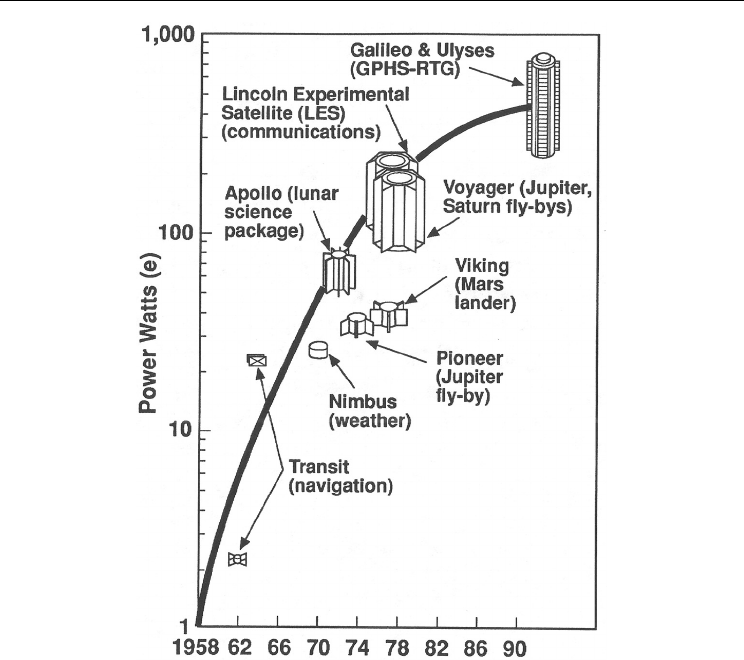
U.S. Space Radioisotope Power Systems and Applications: Past, Present and Future
485
Fig. 10. Progress in RTG development. (Rockwell, 1992)
8. Multi-mission Radioisotope Thermoelectric Generator (MMRTG)
Following the successes of such flagship missions as Galileo and Cassini, NASA turned its
attention to providing smaller “faster, better, cheaper” science spacecraft. In looking for
an RPS which would satisfy that mandate along with being able to operate both in space
and on the surface of a planetary body (e.g., Mars), a joint NASA/DOE team
recommended development of the Multi-Mission Radioisotope Thermoelectric Generator
(MMRTG) along with the development of the higher efficiency Advanced Stirling
Radioisotope Generator (ASRG) (see Section 10) (unpublished Report of the RPS
Provisioning Strategy Team, 2001).
The MMRTG, built by Rocketdyne and Teledyne, is based on the telluride thermoelectric
technology used in the SNAP-19 RTG program which had shown that it could work in space
(Nimbus III, Pioneers 10/11) and on a planetary surface (Viking Landers 1 and 2). The first
mission to employ the MMRTG will be the Mars Science Laboratory (MSL), whose rover has
been named “Curiosity” (see Figure 11). The 900-kg MSL is scheduled to be launched in the
late fall of 2011 to arrive at Mars in August 2012.
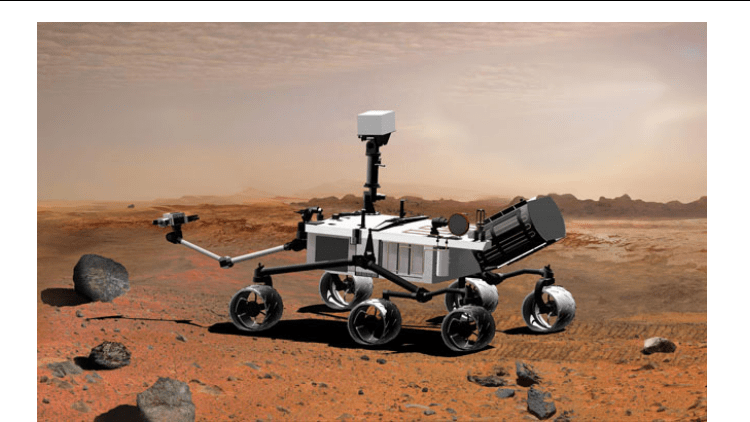
Radioisotopes – Applications in Physical Sciences
486
Fig. 11. Artist’s concept of the Mars Science Laboratory (MSL) Curiosity rover with the
MMRTG shown attached to the back end (right side in the picture). MSL is ~3 m long (not
including the arm), 2.7 m wide, 2.1 m tall with a mass of 900 kg. The arm can reach about 2.1
m. (Image credit: NASA/JPL/Caltech).
The overarching science goals of the MSL mission are to search for clues about whether
environmental conditions (such as the existence of water for significant periods) could support
microbial life today or in the past, and to assess whether the environment has favored the
preservation of this evidence. MSL will be the first interplanetary mission to use a sky crane to
land and the first to use guided entry to land in a precise location. MSL is designed to last for
one Mars year (~687 Earth days) and to travel 20 km during its prime mission.
The MMRTG is designed to provide about 110 We on the surface of Mars at 28 to 32 V. The
conversion is achieved using 16 thermoelectric modules of 48 telluride-based thermoelectric
elements (Hammel, et al., 2009).
The MMRTG is designed to have a minimum lifetime of 14
years. The MMRTG employs a flexible modular design approach that would allow the
MMRTG concept to meet the power requirements of a wide range of missions.
Figure 12 shows a cutaway of the MMRTG. The MMRTG gets its ~2-kWt of thermal power
from eight GPHS modules, the same heat source technology that was successfully used in the
GPHS-RTGs and is planned for use in the ASRG. Like the GPHS-RTG, the converter housing
and the eight heat rejection (radiator) fins are made of aluminum. The core assembly with 16
thermoelectric modules, each containing 48 couples (see Figure 13), are located under the eight
fins with eight pairs of two modules aligned axially (Hammel, et al., 2009).
The thermoelectric modules are spring loaded to enhance conduction of heat from the GPHS
modules and to enhance conduction of heat from the cold junction of the thermoelectric
elements into the module bar and then into the converter housing. A bulk insulation system
composed of the material Min-K reduces heat losses, in effect forcing the heat to travel
through the thermoelectric elements. To enhance reliability the thermoelectric couples are
electrically arranged in series and parallel. This redundant arrangement prevents loss of
power should one or even several thermoelectric elements fail (Hammel, et al., 2009).
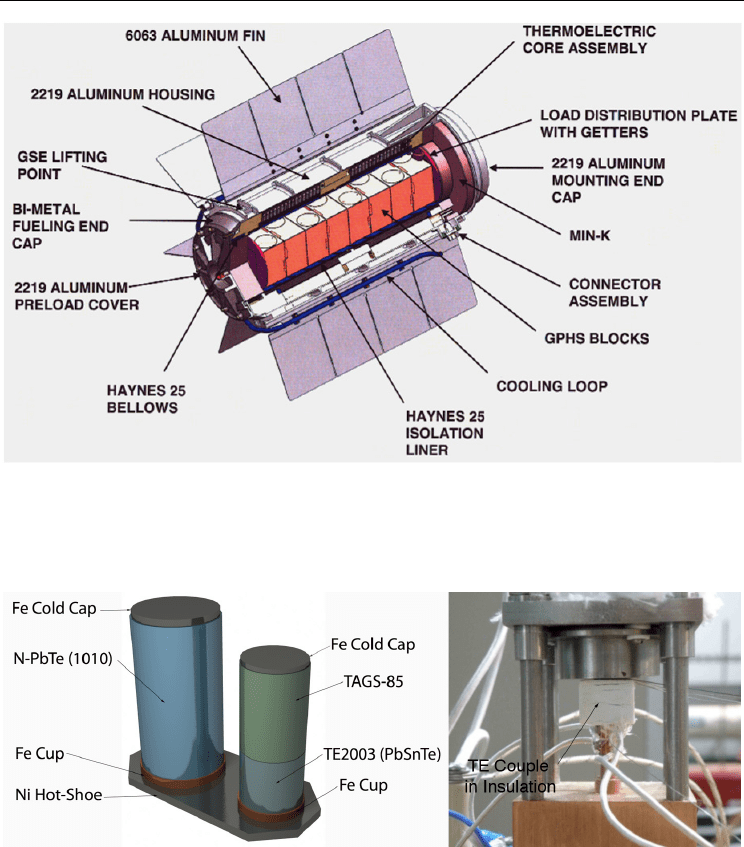
U.S. Space Radioisotope Power Systems and Applications: Past, Present and Future
487
Fig. 12. Cutaway of the Multi-Mission Radioisotope Thermoelectric Generator (Hammel,
et al., 2009) The MMRTG is designed to produce ~110 We at BOM with a mass of ~45 kg.
The MMRTG is about 64 cm in diameter (fin-tip to fin-tip) by 66 cm long. (Image credit:
DOE).
Fig. 13. The MMRTG Thermoelectric (TE) Couple in illustration and in a Test Fixture (Image
credit: NASA/JPL/Caltech)
Like the SNAP-19 RTGs, the MMRTG is a sealed RTG with a cover gas. (The MHW-RTGs,
GPHS-RTGs and Transit RTG were operated in a vacuum.) The heat source is sealed from the
converter by a thin metal liner. Helium buildup from the natural decay of the Pu-238 fuel is
prevented by venting it directly to the exterior of the MMRTG. The hermetically sealed
converter contains an argon cover gas that reduces parasitic heat losses and protects the
thermoelectric elements. With this venting and cover gas arrangement the MMRTG can
operate in space or in an atmosphere (e.g., the surface of Mars or Titan) (Hammel, et al., 2009).
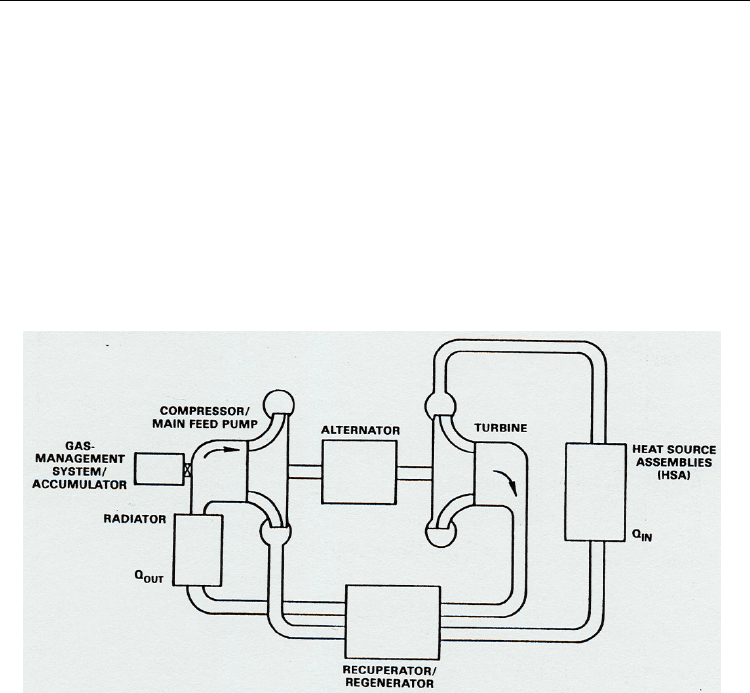
Radioisotopes – Applications in Physical Sciences
488
Modeling of the MMRTG performance indicates that the MMRTG will be able to provide
the necessary power to enable MSL to achieve its objectives (Hammel, et al., 2009).
9. Dynamic Isotope Power System (DIPS)
The Dynamic Isotope Power System (DIPS) program was initiated in 1975 to provide increased
power from radioisotope heat sources by using more efficient dynamic conversion systems
(Brayton and Rankine). The precedent had been established in the 1950s with the SNAP-1
program (see Section 2) with its mercury Rankine conversion system and the SNAP-2 (3 kWe)
and SNAP-8 (30 to 60 kWe) mercury Rankine space reactor programs. In terms of mass and
specific power DIPS fills the gap between RTGs and nuclear reactors; in short, it could be the
next logical step for increased RPS power after RTGs. Figure 14 illustrates the basic features of
a representative DIPS (either Brayton or Rankine) (Bennett and Lombardo, 1989).
Fig. 14. Functional diagram of a generic Dynamic Isotope Power System (DIPS) (Bennett and
Lombardo, 1989).
The original DIPS program was focused on producing a 1.3 kWe radioisotope power source
with a mass of ≤204 kg using either a Brayton conversion system or an organic Rankine
conversion system. The Brayton conversion system built upon the experience of NASA and
its contractors (e.g., Garrett Corporation) dating from 1965 in developing a 2 to 10 kWe
closed Brayton cycle (CBC) power system. In parallel, work on ground-based Rankine cycle
systems led what was then Sundstrand Corporation to propose using Dowtherm A or
toluene as a working fluid in order to avoid the corrosion issues with liquid-metal Rankine
systems (Bennett and Lombardo, 1989).
Based on actual hardware tests, both the CBC and the organic Rankine cycle (ORC) were
shown to be capable of meeting the DIPS goals. The organic Rankine cycle was chosen for
further testing. The lack of a mission led to the termination of the program in 1980 but in
1986 the U.S. Air Force expressed interest in having a DIPS for its Boost Surveillance and
Tracking System (Bennett & Lombardo, 1989). The DIPS program was restarted with
Rocketdyne as the systems contractor and Sundstrand and Garrett as subcontractors.
